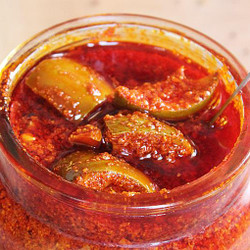Wash mangoes thoroughly and soak in a large wide pail or bucket for 1 hour. This is done to remove any dirt deposited on them.
Remove them from water and allow to dry.
Wipe them with a cloth and spread them on a large cotton cloth. They must be completely moisture free and dry.
The place where you intend to make the pickle has to be absolutely clean, dry and free from moisture.
Move the mangoes to this work area and all the preparation has to be done here to prevent spoilage. Get all the other things we prepared the previous day to this place . (Read the preparation part from the blog post)
Remove any portions of stems still on the mangoes. Cut each mango to half, with the shell and kernel intact. Mango can also be wrapped in a cotton cloth and then halved to prevent slipping or injury. If the shell or the covering of the kernel gets separated from the pieces, they are not used for pickle since they turn soggy and the taste of the entire pickle changes.
With the help of a spoon, remove the kernel and discard. You can also see a paper thin layer in between the kernel and the inner portion of the shell. Remove that as well. Use a spoon to remove that completely. Wipe off with a clean dry cloth.
Cut each halved mango to 2 (quarters) and then further to 3 pieces each. This way a medium sized mango gets about 12 pieces. Make sure each piece also has a shell part on it.
Measure & place these cut pieces on a cloth or utensil.
Peel the garlic cloves. Make sure they don't have any green shoots at the base. Set them aside. We also crush lightly 10 garlic cloves. This is optional. If the garlic cloves turn green, do not use them.
Powder the mustard seeds. Measure 1 cup and add it to a large dry utensil. Set aside the left over.
Powder the methi seeds if using. Add this to the same utensil along with mustard powder.
Powder the crystal salt. Measure ¾ cup plus 2 tbsp powdered salt and add it to the utensil. Also measure and add red chili powder, garlic. Mix all these.
Pour 1½ cups oil to another dry utensil. Dunk the mango pieces in the oil, a handful at one time. Take them off from the oil with a deep frying spatula or slotted spoon. Add them to the spice mix. Coat them well with spice powder and add it to the bharani/ glass jar.
Repeat this process of dunking a handful of them in oil and then in the spice mix. Then to the bharani/ jaadi. Once you are done, there will no spice mix left. You may be short of oil for the last few batches. Then use up the rest of the half cup.
When you are done with this, if you are left with oil or any spice powder, just add the spice powder and then pour the oil to the jar.
Cover with a lid. Place a cotton cloth and then tie up with a cloth ribbon or a thin long piece of cloth, across the neck of the jar.
Keep this in a dry cabinet/shelf for 3 full days. We wait for 72 hours.
On the fourth day, open the lid and then mix up using a dry ladle. We use strong wooden ladles when made in large quantity.
Taste the pickle and add little more salt if needed. Wait till the next day to check if there is a layer of oil floating on the pickle, if not add the rest of the oil.
Do not skimp on the salt and oil, they act as natural preservatives to preserve pickle for a year. If there is not enough oil or salt, pickle may get spoilt.
Do not serve pickle directly from the jar especially if you have made in large quantity. Opening the jars frequently will diminish the quality, color and flavour of pickle. Always take a portions of this to another glass bottle for everyday use.
Always use dry hands, ladles and spoons while handling the pickles. We usually heat them up a bit near the gas flame.
